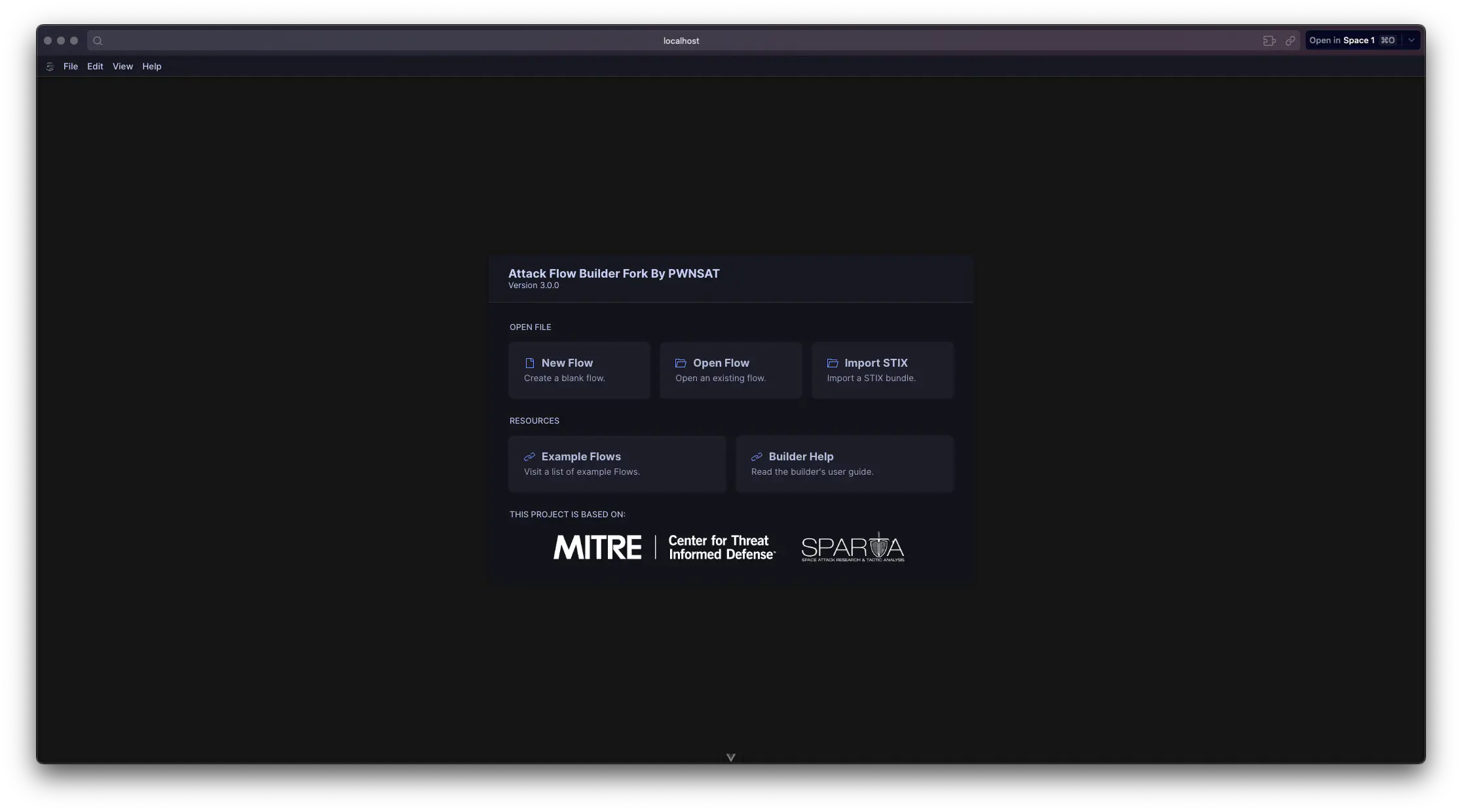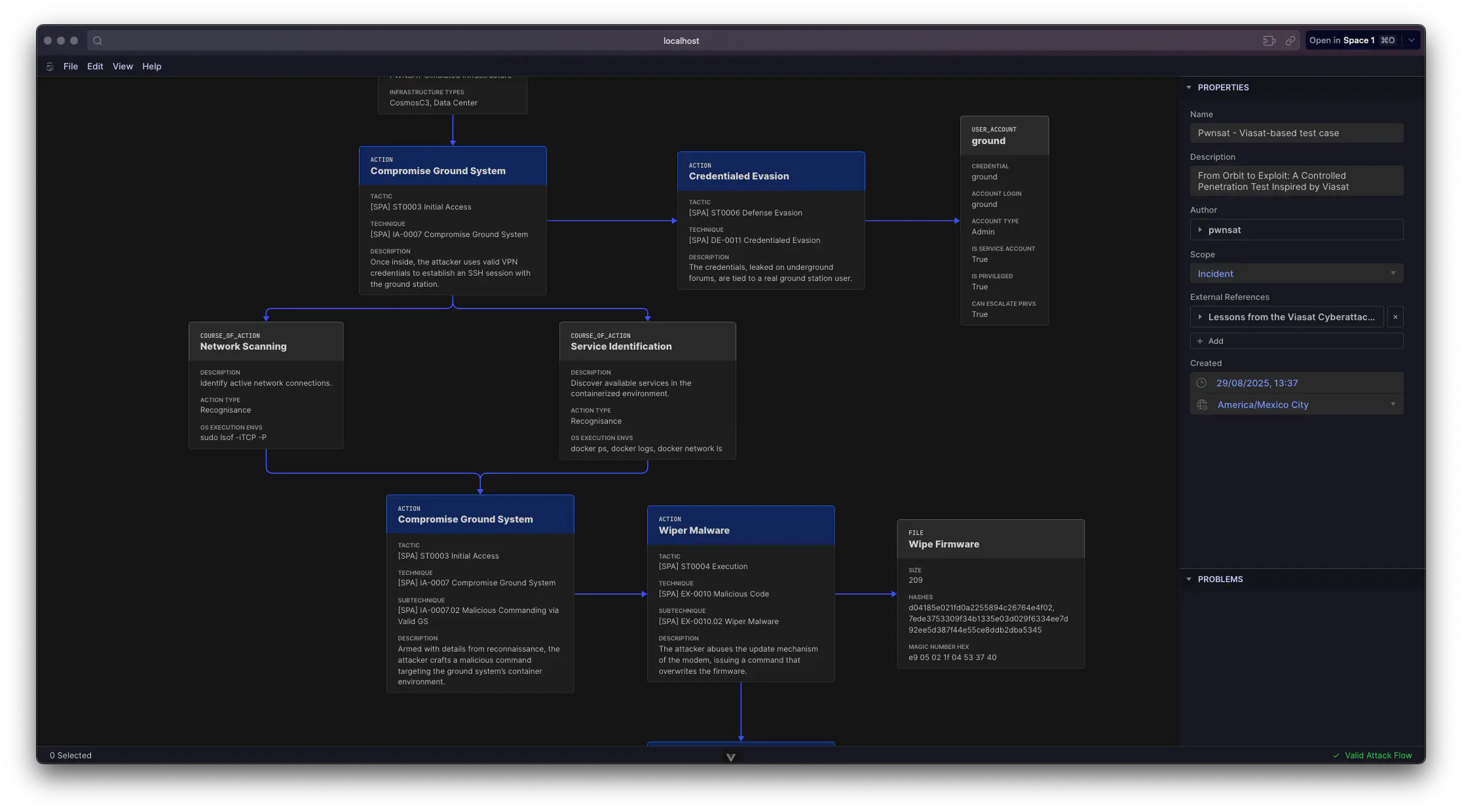
From MITRE ATT&CK to SPARTA: A Unified Attack Flow for Space Systems
Written by: Kevin Leon
One of the most powerful aspects of cybersecurity research is the ability to extend and adapt existing tools to cover new domains. While the Attack Flow Builder from MITRE was originally designed to visualize and model cyber operations based on the MITRE ATT&CK framework, I needed to go a step further for my research in space cybersecurity.
The challenge: how to integrate SPARTA (a cybersecurity framework for space systems) into the Attack Flow Builder so that we can model attacks not only in traditional IT/OT contexts, but also in the space domain.
This post documents the process of extending Attack Flow Builder, the technical details of the integration, and the results of enabling hybrid attack flows that combine MITRE ATT&CK with SPARTA.
If you want to test this fork check the repo.

Technical Approach
1. Understanding the data model
Attack Flow Builder consumes Structured Threat Information Expression (STIX™), which define tactics, techniques, and relationships from MITRE ATT&CK. To integrate SPARTA, I needed to generate an equivalent dataset that followed the same schema while preserving SPARTA’s unique identifiers (e.g., REC-0001, EX-0002).
SPARTA already provides a STIX dataset with its TTPs, but this is not directly compatible with Attack Flow Builder. Some identifiers and relationships had to be restructured in order to be usable.
2. Mapping identifiers
MITRE ATT&CK uses identifiers such as TA0001 or T1003. SPARTA, however, defines techniques with a PREFIX-NUMBER pattern (e.g., EX-0001).
Since MITRE ATT&CK works with Tactics and Techniques, I modified the parsing logic in Attack Flow Builder to also support sub-techniques for SPARTA.
Accept Tactics
The original regex filtered only TA tactics:
return tactText.split(/TA\d+/)[1].trim();
I modified it to accept SPARTA as well:
return tactText.split(/(TA|ST)\d+/)[1].trim();****
Although this is a non-generic solution, it works for the purposes of this integration.
Accept Techniques
Techniques were originally filtered with:
return techText.split(/T\d+(?:\.\d+)?/)[1].trim();
I replaced it with a more generic regex that works for both MITRE and SPARTA identifiers:
return techText.split(/(T|[A-Z]+-?)\d+(?:\.\d+)?/)[1].trim();
This regex expression it’s more generic than the tactics implementation.
3. Modifying the builder logic
Several adjustments were necessary in Attack Flow Builder’s parsing and rendering pipeline:
- Recognize SPARTA identifiers as techniques.
- Add support for sub-techniques.
- Update the visualization layer so SPARTA nodes render seamlessly within flows.
Adding the sub-techniques
Attack Flow Builder uses attack-pattern for techniques. SPARTA, however, required additional logic to support sub-techniques. I extended the mapping inside STIX_TO_ATTACK as follows:
/**
* A map that relates STIX types to ATT&CK types.
*/
const STIX_TO_ATTACK = {
// ... Others STIX relations
"x-mitre-tactic": "tactic",
"attack-pattern": "technique",
"attack-subpattern": "subtechnique"
}
In this case I mapped the attack-supattern with the subtechnique relationship. In Attack Flow Builder use the attack-pattern for refer to techniques and by the STIX file for SPARTA use this attack-pattern identifier by all the TTP’s so this was the first bigger modification that I need to consider.
Then, I need to add the logic to the update_mitre_attack.mjs, this files is used by the command npm run update-attack to download the latest release of each attack supported, and export the mapped data to the MitreAttacks.ts which it’s the “db” for attacks.
To allow the support for sub-techniques and mapping this, I add the next code to the update_mitre_attack, first SPARTA their techniques can have their sub-techniques, but since not all have their sub-items, I add a validation, if the the techniques have sub-techniques then the complete tree , otherwise use technique with the tactic.
async function updateApplicationAttackEnums(path, ...urls) {
// ... Rest of the code
for(const tact of types.get("tactic")) {
if(tact.deprecated) {
continue;
}
// Format matrix
const matrix = tact.domains.map(
o => o.substring(0,3).toLocaleUpperCase()
).join(", ");
// Format tactic
tactics.push([
tact.id, `[${matrix}] ${tact.id} ${tact.name}`
]);
for(const tech of tact.techniques) {
if (tech.subtechniques != undefined){
for(const subtech of tech.subtechniques){
relationships.push(["tactic", tact.id, "technique", tech.id, "subtechnique", subtech.id]);
}
}else{
relationships.push(["tactic", tact.id, "technique", tech.id]);
}
}
stixIds[tact.id] = tact.stixId;
}
tactics.sort(([a],[b]) => a.localeCompare(b));
// Organize subtechniques
const subtechniques = [];
for(const tech of types.get("subtechnique")) {
if(tech.deprecated) {
continue;
}
const matrix = tech.domains.map(
o => o.substring(0,3).toLocaleUpperCase()
).join(", ");
subtechniques.push([tech.id, `[${matrix}] ${tech.id} ${tech.name}`]);
stixIds[tech.id] = tech.stixId;
}
subtechniques.sort(([a],[b]) => a.localeCompare(b));
// Generate enums file
let file = "";
file += `export const ${ EXPORT_KEY } = `;
file += JSON.stringify({ tactics, techniques, subtechniques, relationships, stixIds });
file += `;\n\nexport default ${ EXPORT_KEY };\n`
writeFileSync(path, file);
// Done
console.log("\nMITRE ATT&CK enumerations updated successfully.\n");
}
4. Results
With these changes (and several minor adjustments), Attack Flow Builder now supports hybrid attack flows.
A researcher can, for example, model an intrusion scenario where initial access is described with ATT&CK (T1078 – Valid Accounts) and lateral movement is described using SPARTA (LM-0007 – Credentialed Traversal).
This cross-domain visibility is crucial for analyzing cyber threats to space-ground systems, where enterprise IT attacks intersect with satellite-specific vulnerabilities.

Why This Matters
The integration highlights two key insights:
- Extensibility of MITRE tools – with minor modifications, existing frameworks can be adapted to entirely new domains.
- Bridging IT and Space Cybersecurity – researchers now have a way to represent and analyze threats that cross from enterprise IT systems into spacecraft operations.
This work is not about replacing ATT&CK or SPARTA, but about making them interoperable in a way that improves threat modeling and visualization for the community.
About Attack Flow
This work is a fork of the Attack Flow Builder, originally created and maintained by the MITRE Center for Threat-Informed Defense to advance the state of the art in threat-informed defense.
According to the official repository:
“This project is created and maintained by the MITRE Center for Threat-Informed Defense in furtherance of our mission to advance the state of the art and the state of the practice in threat-informed defense globally. The project is funded by our research participants.”
This fork is maintained independently by the PWNSAT team and is not affiliated with MITRE or the Center for Threat-Informed Defense.
Disclaimer
This project is an independent fork of MITRE’s Attack Flow Builder. It is maintained by the PWNSAT team for research and educational purposes.
- MITRE, the MITRE ATT&CK framework, and Attack Flow Builder are trademarks or registered projects of The MITRE Corporation.
- SPARTA is an independent initiative maintained by the Aerospace Corporation.
- This fork and the modifications described here are not endorsed, sponsored, or supported by MITRE, the Center for Threat-Informed Defense, or the Aerospace Corporation.
Use of this project should comply with the terms of the Apache 2.0 License under which Attack Flow Builder was originally released. Any responsibility for modifications, integration errors, or derived results lies solely with the maintainers of this fork.